Abstract
OBJECTIVES: To determine whether family physicians prefer discharge summaries in narrative or standardized format and to determine factors affecting this preference. DESIGN: Mailed survey. SETTING: Internal medicine ward at a teaching hospital. PARTICIPANTS: Random sample of 180 family physicians practising in the Ottawa-Carleton area. Of the original sample, 20 were not family physicians and were excluded. Of the 160 physicians remaining, 126 responded for a response rate of 78.8%. INTERVENTION: For a stratified random sample of patients, medical records and narrative discharge summaries were abstracted using a data acquisition form to capture essential information. Information on completed forms was transformed into standardized summaries. Physicians were sent both narrative and standardized summaries. MAIN OUTCOME MEASURE: Physicians' format preference as indicated on an ordinal 7-point scale. RESULTS: The standardized format was preferred with a score of 4.28 versus 3.84 for the narrative (P < .05). Responses indicated the standardized format provided information most relevant to ongoing care, with a mean score of 4.82 (95% confidence interval [CI] 4.48 to 5.15), and easier access to summary information (5.60, CI 5.30 to 5.89). The narrative summary better described patients' admission (3.54, CI 3.18 to 3.90). Preference for standardized summaries correlated with lengthier narrative summary (P < .05), shorter length of stay (P < .05), and physicians' dissatisfaction with previous summaries (P < .001). Standardized discharge summaries were significantly shorter (302 versus 619 words, P = .004) than narrative summaries. CONCLUSIONS: Physicians preferred a standardized format for discharge summaries. Format preference is influenced by physician, patient, and discharge summary characteristics.
Full text
PDF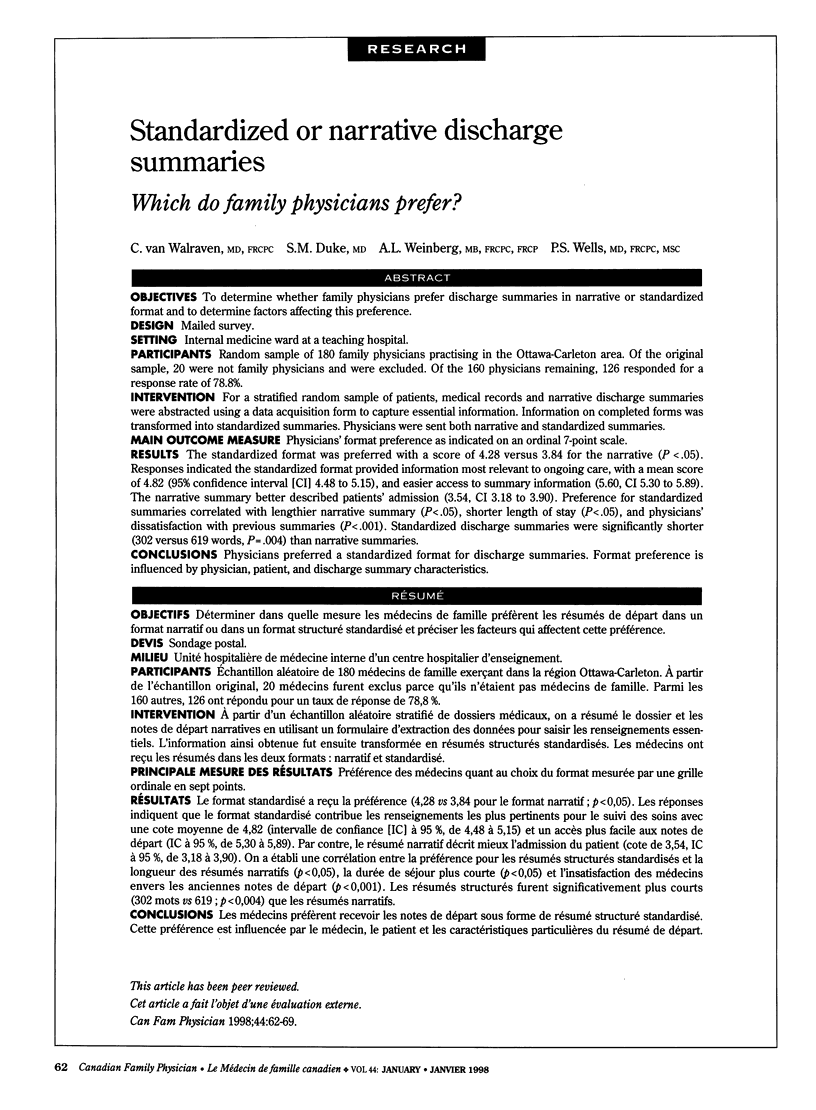
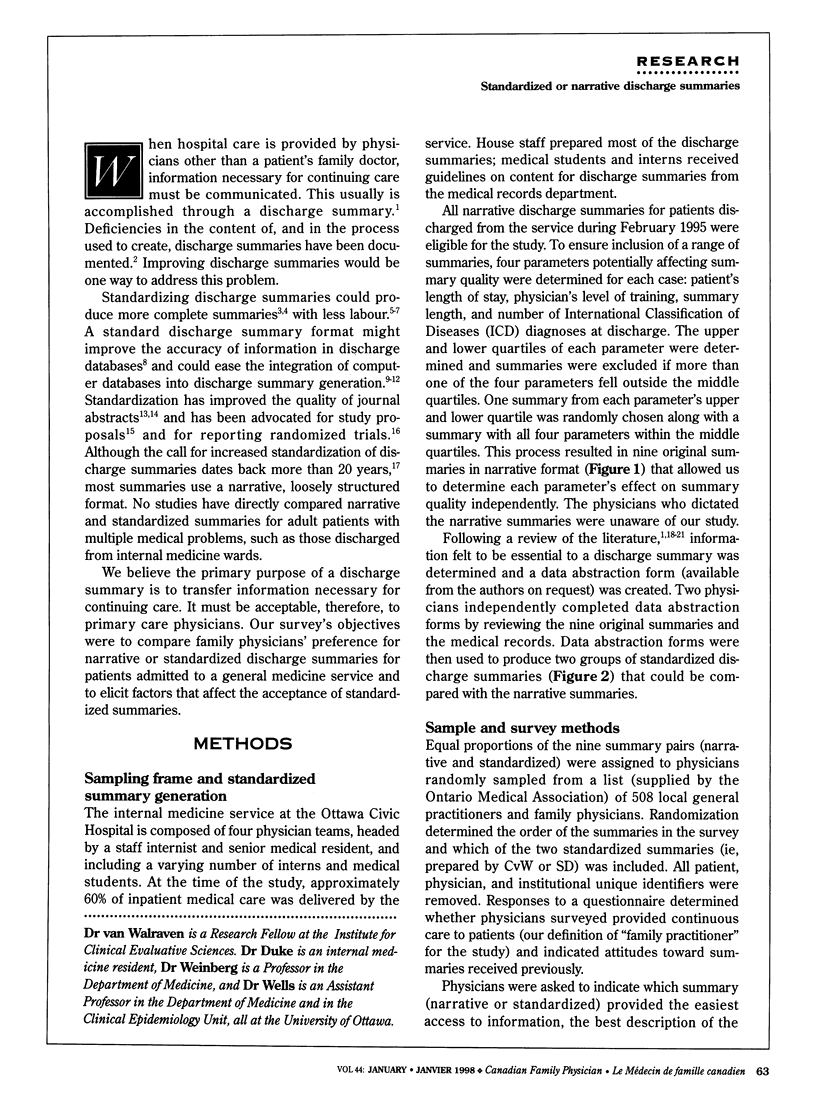
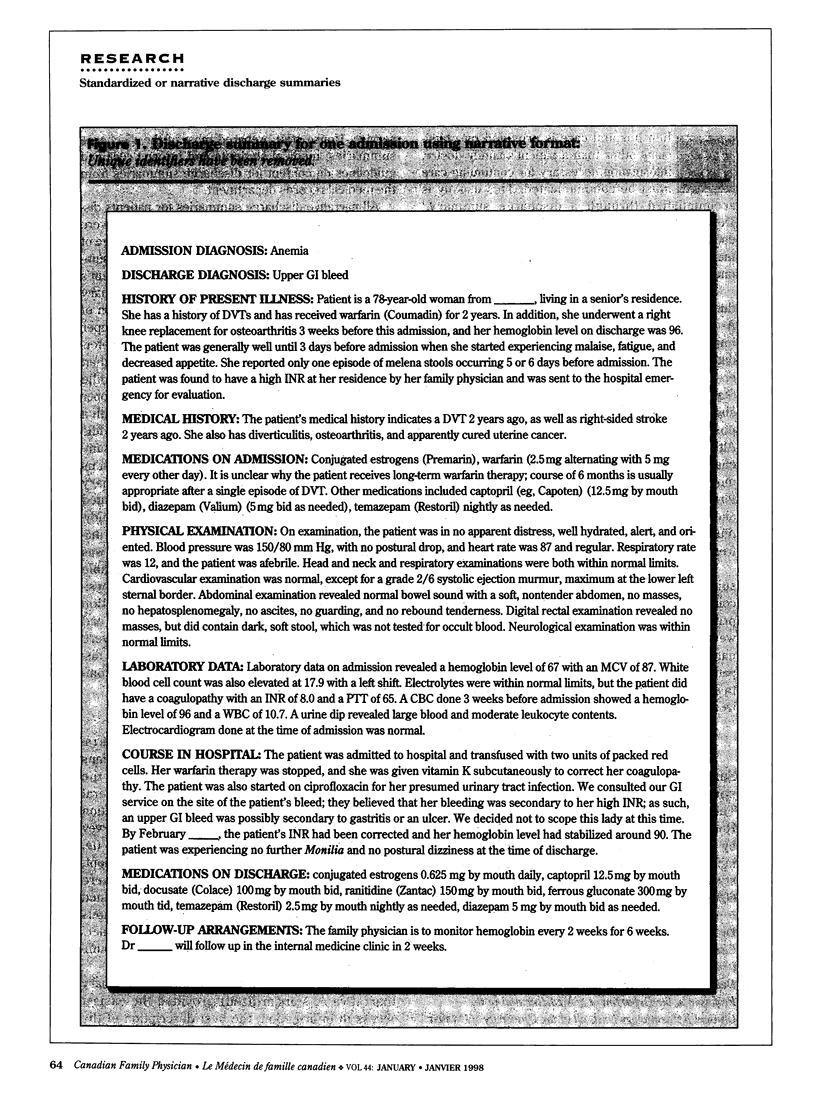
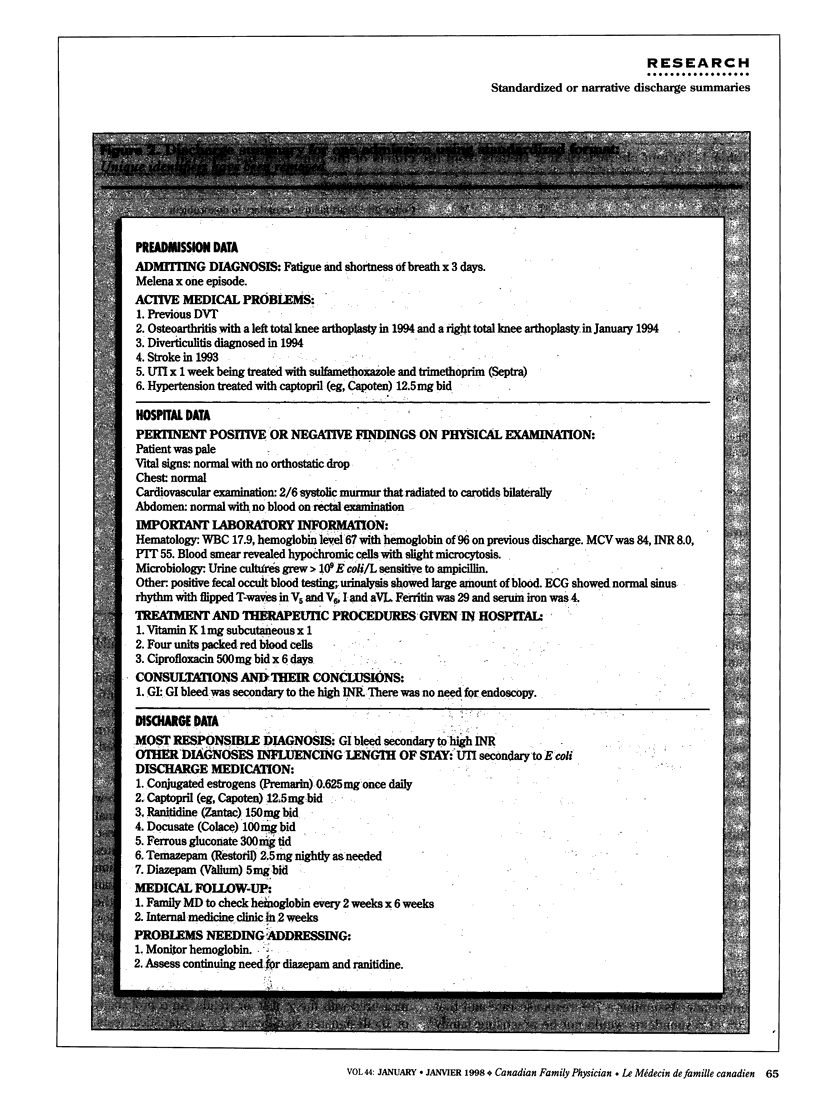

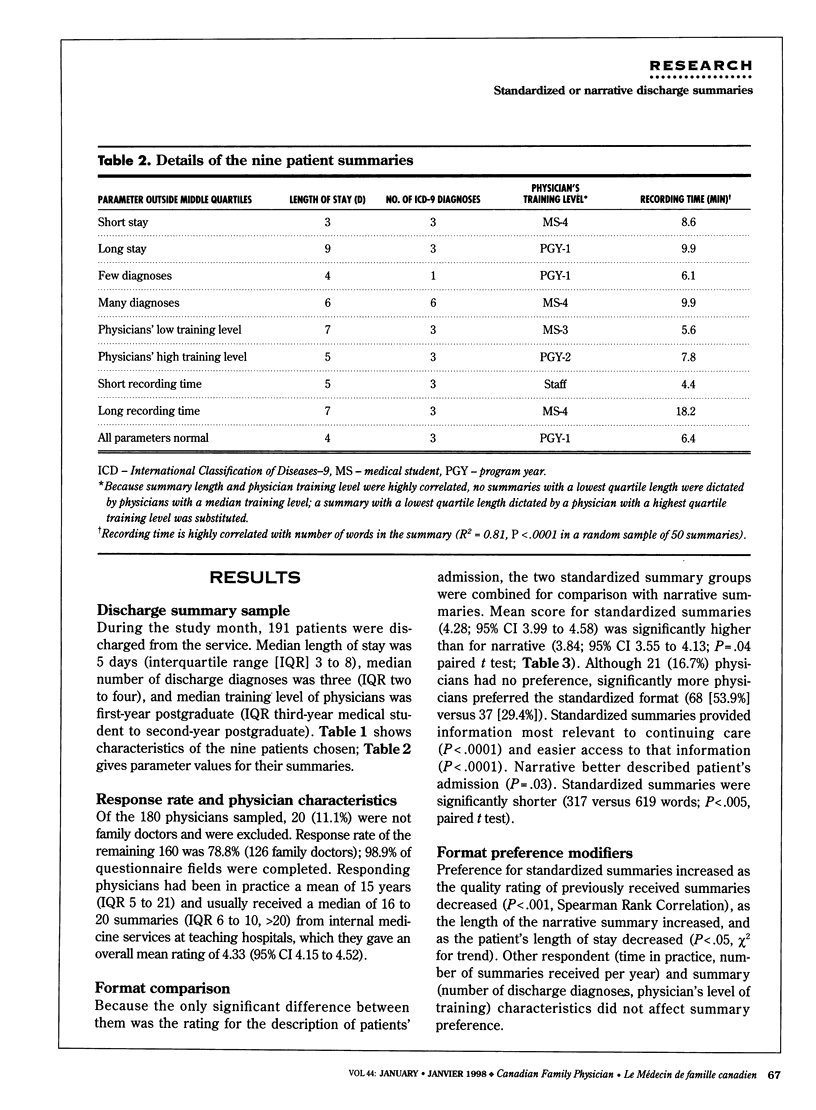
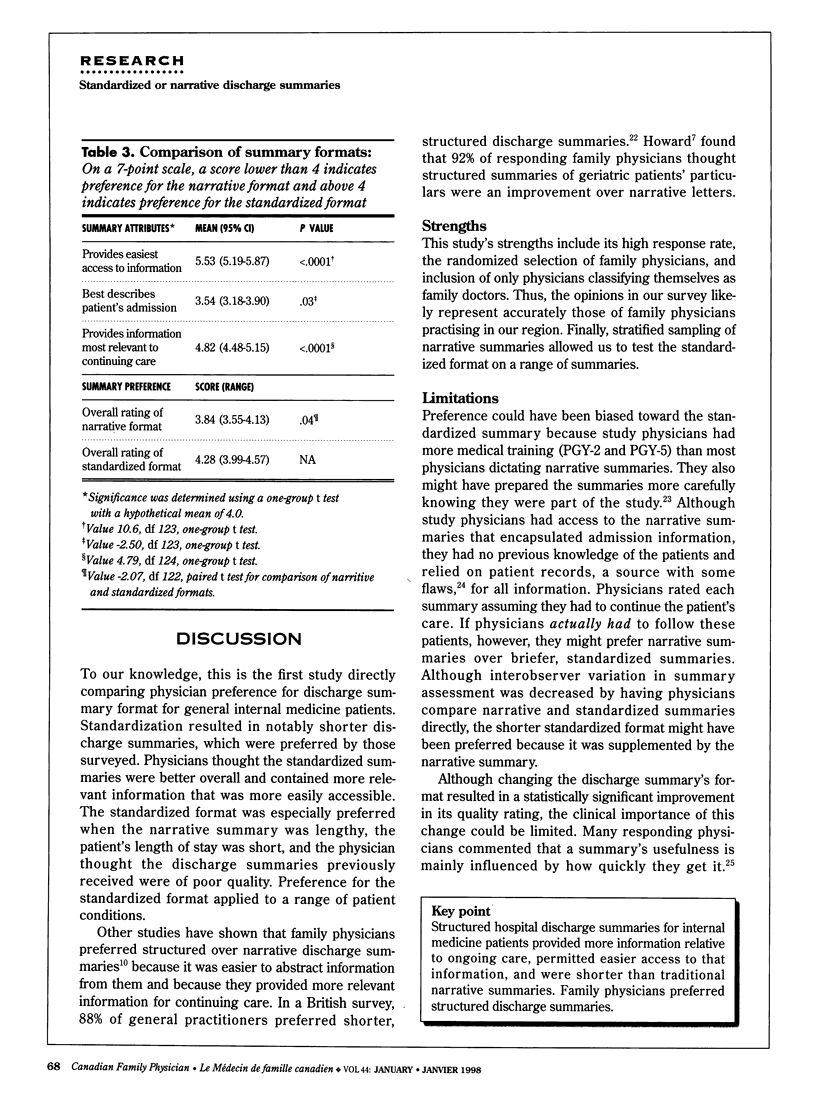

Selected References
These references are in PubMed. This may not be the complete list of references from this article.
- Adams D. C., Bristol J. B., Poskitt K. R. Surgical discharge summaries: improving the record. Ann R Coll Surg Engl. 1993 Mar;75(2):96–99. [PMC free article] [PubMed] [Google Scholar]
- Brazy J. E., Langkamp D. L., Brazy N. D., De Luna R. F. Do primary care physicians prefer dictated or computer-generated discharge summaries? Am J Dis Child. 1993 Sep;147(9):986–988. doi: 10.1001/archpedi.1993.02160330076024. [DOI] [PubMed] [Google Scholar]
- Escorihuela R., Quero J., Arbelo Curbelo A., Rubio D., Pérez Rodríguez J., Escrivá R. M., López De Letona A. A. Informe de alta. An Esp Pediatr. 1976 May-Jun;9(3):310–314. [PubMed] [Google Scholar]
- Hohnloser J. H., Pürner F. PADS (Patient Archiving and Documentation System): a computerized patient record with educational aspects. Int J Clin Monit Comput. 1992;9(2):71–84. doi: 10.1007/BF01142184. [DOI] [PubMed] [Google Scholar]
- Howard D. J. Structured discharge letter in a department of geriatric medicine. Health Trends. 1986 Feb;18(1):12–14. [PubMed] [Google Scholar]
- King M. H., Barber S. G. Towards better discharge summaries: brevity and structure. West Engl Med J. 1991 Jun;106(2):40-1, 55. [PMC free article] [PubMed] [Google Scholar]
- Lenhard R. E., Jr, Buchman J. P., Achuff S. C., Kahane S. N., Macmanus C. J. AUTRES--the Johns Hopkins Hospital automated resume. J Med Syst. 1991 Jun;15(3):237–247. doi: 10.1007/BF00996553. [DOI] [PubMed] [Google Scholar]
- Long A., Atkins J. B. Communications between general practitioners and consultants. Br Med J. 1974 Nov 23;4(5942):456–459. doi: 10.1136/bmj.4.5942.456. [DOI] [PMC free article] [PubMed] [Google Scholar]
- Malone K. M., Szanto K., Corbitt E. M., Mann J. J. Clinical assessment versus research methods in the assessment of suicidal behavior. Am J Psychiatry. 1995 Nov;152(11):1601–1607. doi: 10.1176/ajp.152.11.1601. [DOI] [PubMed] [Google Scholar]
- Manning R. T. Dictation of the discharge resumé: a forgotten link between the spoken and written word. J Gen Intern Med. 1989 Sep-Oct;4(5):453–456. doi: 10.1007/BF02599699. [DOI] [PubMed] [Google Scholar]
- Naylor C. D., Williams J. I., Guyatt G. Structured abstracts of proposals for clinical and epidemiological studies. J Clin Epidemiol. 1991;44(8):731–737. doi: 10.1016/0895-4356(91)90123-q. [DOI] [PubMed] [Google Scholar]
- Newton J., Eccles M., Hutchinson A. Communication between general practitioners and consultants: what should their letters contain? BMJ. 1992 Mar 28;304(6830):821–824. doi: 10.1136/bmj.304.6830.821. [DOI] [PMC free article] [PubMed] [Google Scholar]
- Pears J., Alexander V., Alexander G. F., Waugh N. R. Audit of the quality of hospital discharge data. Health Bull (Edinb) 1992 Sep;50(5):356–361. [PubMed] [Google Scholar]
- Penney T. M. Delayed communication between hospitals and general practitioners: where does the problem lie? BMJ. 1988 Jul 2;297(6640):28–29. doi: 10.1136/bmj.297.6640.28-a. [DOI] [PMC free article] [PubMed] [Google Scholar]
- Penney T. M. Dictate a discharge summary. BMJ. 1989 Apr 22;298(6680):1084–1085. doi: 10.1136/bmj.298.6680.1084. [DOI] [PMC free article] [PubMed] [Google Scholar]
- Romm F. J., Putnam S. M. The validity of the medical record. Med Care. 1981 Mar;19(3):310–315. doi: 10.1097/00005650-198103000-00006. [DOI] [PubMed] [Google Scholar]
- Schiff G. D. Using a computerized discharge summary data base check box for adverse drug reaction monitoring. QRB Qual Rev Bull. 1990 Apr;16(4):149–155. doi: 10.1016/s0097-5990(16)30357-8. [DOI] [PubMed] [Google Scholar]
- Solomon J. K., Maxwell R. B., Hopkins A. P. Content of a discharge summary from a medical ward: views of general practitioners and hospital doctors. J R Coll Physicians Lond. 1995 Jul-Aug;29(4):307–310. [PMC free article] [PubMed] [Google Scholar]
- Stevenson J. G., Boyle C. M., Alexander W. D. A new hospital discharge letter. Lancet. 1973 Apr 28;1(7809):928–931. doi: 10.1016/s0140-6736(73)91378-0. [DOI] [PubMed] [Google Scholar]
- Taddio A., Pain T., Fassos F. F., Boon H., Ilersich A. L., Einarson T. R. Quality of nonstructured and structured abstracts of original research articles in the British Medical Journal, the Canadian Medical Association Journal and the Journal of the American Medical Association. CMAJ. 1994 May 15;150(10):1611–1615. [PMC free article] [PubMed] [Google Scholar]
- van Walraven C., Weinberg A. L. Quality assessment of a discharge summary system. CMAJ. 1995 May 1;152(9):1437–1442. [PMC free article] [PubMed] [Google Scholar]


